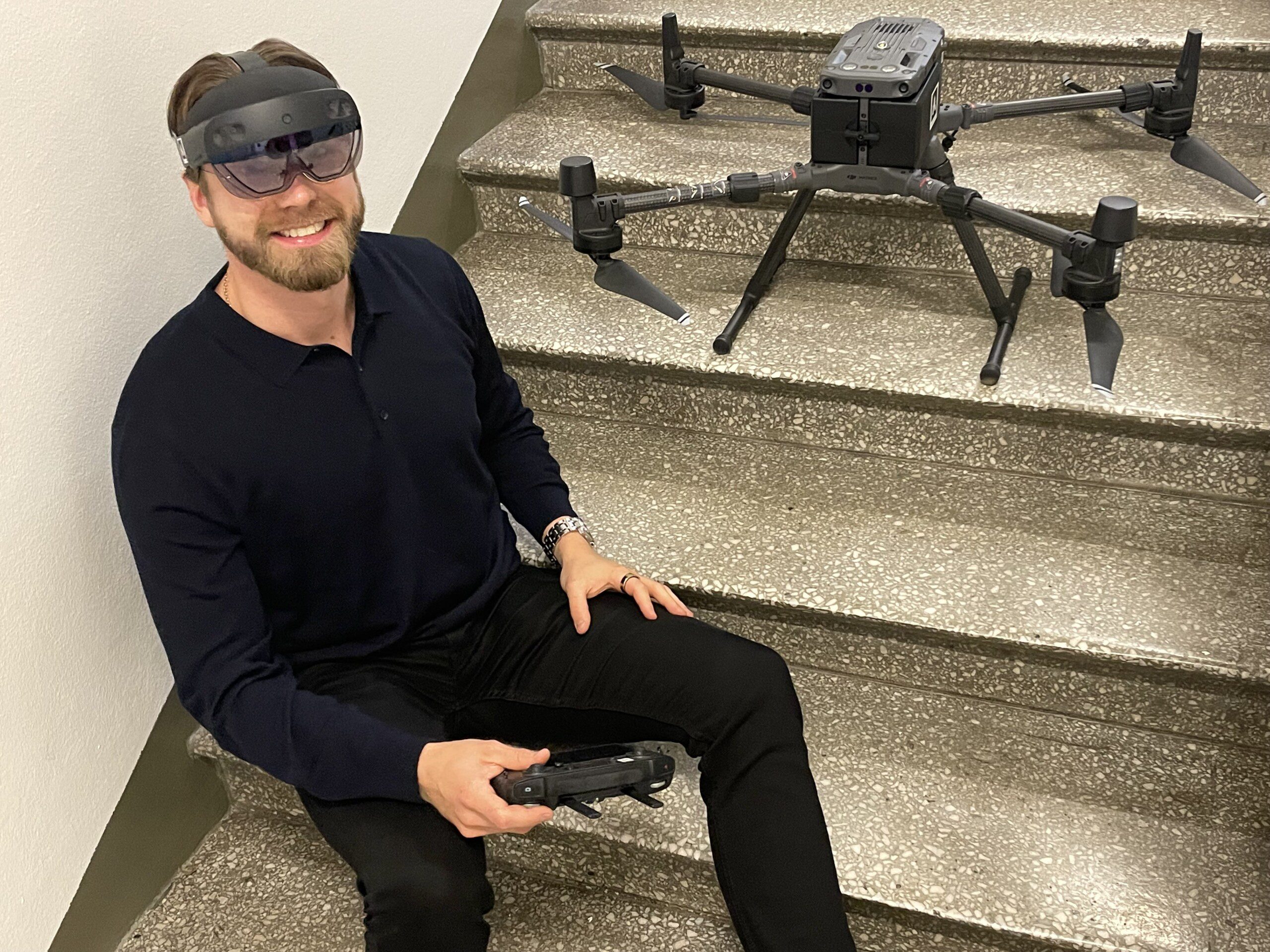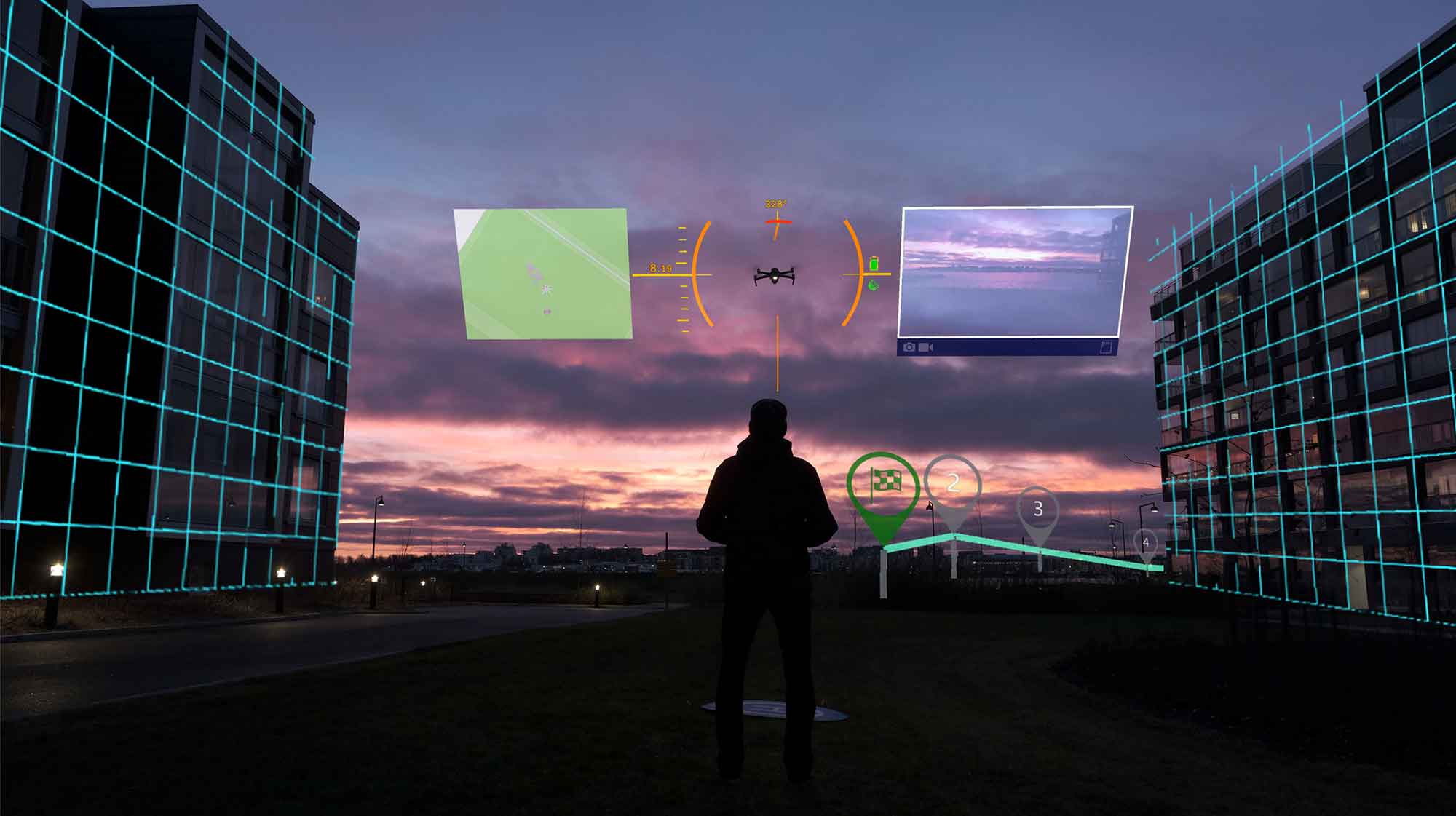How AR glasses can be used to fly drones
To enhance the flying experience of drones, AR glasses provide a heads-up display for real-time telemetry and navigation data, allowing pilots to maintain visual line of sight while monitoring important flight information. These smart glasses are revolutionizing the way industrial drones are flown. With AR glasses, pilots can fly drones with ease and precision.
AR glasses offer a range of features that greatly enhance the pilot’s ability to fly drones. They can overlay augmented reality waypoints and flight paths onto the pilot’s field of view, providing a clear and intuitive interface for navigation. This not only improves situational awareness during flight, but also allows pilots to plan and execute complex flight missions with ease.
Furthermore, AR glasses can display live video feeds from the drone’s camera, allowing pilots to see the drone’s perspective without looking down at a separate screen. This real-time video feed provides a seamless and immersive flying experience, enabling pilots to make quick and accurate decisions while in flight.
In addition to these features, AR glasses can also integrate advanced capabilities like obstacle detection and avoidance. This means that pilots can fly drones with confidence, knowing that the AR glasses will alert them to potential obstacles and help them navigate around them safely.
Industrial AR goggles specifications
When selecting industrial AR goggles, it’s essential to consider their specifications, including resolution, field of view, comfort, connectivity options, and compatibility with different devices. These specifications play a crucial role in enhancing the user experience and ensuring seamless integration with industrial drones.
Firstly, resolution is a key factor to consider when choosing industrial AR goggles. Look for a minimum resolution of 1080p to ensure clear and detailed visuals. This high resolution is necessary for effectively overlaying digital information onto the real-world environment, allowing users to view critical data while operating industrial drones.
Additionally, the field of view (FOV) is another important specification to evaluate. Aim for a minimum FOV of 45 degrees to obtain a wide and immersive viewing experience. This wide FOV enables users to see a larger area of their surroundings, providing better situational awareness while operating industrial drones.
Comfort is also a crucial factor to consider. Look for AR goggles that offer a comfortable fit with adjustable features. This ensures that the goggles can be worn for extended periods without causing discomfort or strain on the user’s head or face. Minimizing blur is another aspect to consider, as it helps prevent eye fatigue during prolonged usage.
Connectivity options and compatibility with different devices are also important considerations. Industrial AR goggles should have seamless connectivity with drones and other devices, allowing for easy data transfer and control. Ensure that the goggles are compatible with the specific models of industrial drones being used to maximize their functionality.
Key features to look out for in AR Goggles
Consider the essential key features to enhance your AR goggles experience when operating industrial drones.
When choosing AR goggles for use with industrial drones, it’s important to look out for certain key features that can greatly improve your overall experience.
First and foremost, ensure that the smart glasses you select have a high-resolution display technology. This will ensure crisp and clear visuals, allowing you to easily see important information overlaid on your real-world environment.
Comfort is also crucial, so look for AR glasses that offer a comfortable fit with adjustable features. This will prevent discomfort during extended use and allow you to focus on your tasks without distractions.
Connectivity options are another important aspect to consider. Make sure the AR glasses you choose are compatible with different devices and offer ease of setup. This will enable seamless integration with your industrial drones and other equipment, making your workflow more efficient.
Additionally, consider the premium features offered by the AR goggles. Look for smooth operation, vibrant displays, and long-lasting battery life. These features will ensure that you can rely on your AR glasses for extended periods of use without any performance issues.
Variations in Display Explained
Birdbath optics position the picture downward, providing a rich projection for an immersive experience with AR glasses.
When it comes to the display of AR glasses, there are variations that can enhance your experience while using them with industrial drones.
One important aspect to consider is the field of view. AR glasses offer a wide field of view, allowing you to see virtual objects seamlessly integrated into your real-world environment. This wide field of view ensures that you don’t miss any important information while operating the drone. It enhances your situational awareness and enables you to make informed decisions quickly.
Another factor to consider is peripheral vision. AR glasses provide an expanded peripheral vision, which means you can see virtual objects and data even when you’re not directly looking at them. This is particularly useful when flying industrial drones as it allows you to monitor multiple data points simultaneously without taking your eyes off the drone’s flight path.
Furthermore, AR glasses use micro OLED displays to create vibrant and high-resolution images. These displays ensure that the virtual objects projected into your field of view are clear, detailed, and visually engaging. This is crucial when using AR glasses with industrial drones, as you need to accurately interpret the information presented to you.
Operating systems used
Smart glasses used with industrial drones can have different operating systems depending on the model and manufacturer. Some smart glasses have their own operating system, while others rely on separate devices for connectivity. When choosing smart glasses with an operating system, it’s important to evaluate the compatibility with different devices. Consider the ease of connectivity and setup process to ensure smooth integration with your industrial drone.
One aspect to consider is power consumption. Some smart glasses draw power from the devices they’re connected to, such as smartphones or tablets. This can be advantageous as it reduces the need for separate charging or battery replacement. However, it’s important to ensure that the connected device has sufficient battery life to support both the drone operations and the smart glasses.
Additionally, the operating system of the smart glasses may influence the functionality and features available. Look for smart glasses with a customizable augmented reality (AR) workspace or a private screen, depending on your preferences and specific use cases. These features can enhance your experience and productivity while using the smart glasses with industrial drones.
Another consideration is the availability of software and applications compatible with the operating system. Certain operating systems may have a wider range of AR applications and tools specifically designed for industrial use, allowing you to perform tasks such as real-time data visualization, object recognition, or remote collaboration.
Fields of View
When evaluating smart glasses for use with industrial drones, one important aspect to consider is the field of view (FOV), which refers to the extent of the visible environment or screen content that the wearer can see at any given moment. The FOV in AR smart glasses is measured in degrees and plays a crucial role in determining the immersive experience and range of vision provided by the glasses. A wider field of view can offer a more immersive and natural experience as it allows for a broader range of virtual content to be seamlessly integrated into the physical environment.
The field of view directly impacts your ability to interact with and perceive virtual elements in your surroundings, making it an important factor when choosing AR smart glasses. A wider field of view contributes to a more comprehensive and seamless integration of digital content into the physical world, enhancing the overall user experience and practical applications of the smart glasses in industrial drone operations.
When using smart glasses with industrial drones, a wider field of view can provide you with a better understanding of your surroundings, allowing for more efficient and precise control of the drone. It enables you to view important information, such as telemetry data, flight paths, and real-time video feeds, without obstructing your natural field of vision.
However, it’s important to note that a wider field of view may come at the cost of reduced battery life and picture quality. Some smart glasses may compromise on these aspects to achieve a wider field of view. Additionally, it’s crucial to consider the privacy policy of the smart glasses manufacturer to ensure the protection of sensitive information and data transmitted through the glasses.
Voice controls
Voice controls revolutionize the way you operate AR smart glasses and industrial drones, allowing for hands-free operation and seamless interaction with your surroundings. With voice controls, you can easily give commands and navigate interfaces without the need for manual input, enhancing convenience and efficiency. This feature enables you to initiate tasks, access information, and interact with AR content simply by speaking, freeing up your hands to focus on other important tasks.
The integration of voice recognition technology with AR smart glasses and industrial drones ensures accurate interpretation of your commands, minimizing errors and streamlining operations. This advanced technology enables your smart glasses or drones to understand your voice and respond accordingly, enhancing user experience and productivity in various work environments.
Imagine being able to control your industrial drone’s flight path or access specific AR content on your smart glasses just by speaking commands. Voice controls enable you to do exactly that, making it easier than ever to interact with your devices and surroundings. Whether you’re a technician in a factory, a field engineer inspecting infrastructure, or a first responder in an emergency situation, voice controls provide a convenient and efficient way to operate your AR glasses and drones.
In addition to hands-free operation, voice controls also enhance safety by minimizing distractions. Instead of having to manually input commands or interact with physical interfaces, you can focus on your surroundings while still maintaining control over your devices. This is particularly crucial in high-risk environments where your attention needs to be fully engaged.






